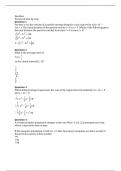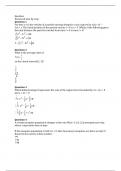For time t ≥ 0, the velocity of a particle moving Study guides, Class notes & Summaries
Looking for the best study guides, study notes and summaries about For time t ≥ 0, the velocity of a particle moving? On this page you'll find 2 study documents about For time t ≥ 0, the velocity of a particle moving.
All 2 results
Sort by

-
For time t ≥ 0, the velocity of a particle moving along the x-axis is given by v(t) = x3 − 3x2 + x. The initial position of the particle at time t = 0 is x = 3. Which of the following gives the total distance the particle traveled from time t = 0 to time
- Exam (elaborations) • 14 pages • 2024
-
- $13.57
- + learn more
For time t ≥ 0, the velocity of a particle moving along the x-axis is given by v(t) = x3 − 3x2 + x. The initial position of the particle at time t = 0 is x = 3. Which of the following gives the total distance the particle traveled from time t = 0 to time t = 4? Question 2 What is the average value of on the closed interval [1, 3]? Question 3 Which definite integral represents the area of the region that is bounded by 3x + 3y2 = 0 and y = 2x + 1? Question 4 A certain mosquito popula...

-
For time t ≥ 0, the velocity of a particle moving along the x-axis is given by v(t) = x3 − 3x2 + x. The initial position of the particle at time t = 0 is x = 3. Which of the following gives the total distance the particle traveled from time t = 0 to time
- Exam (elaborations) • 14 pages • 2024
-
- $9.99
- + learn more
Question Answered step-by-step Question 1 For time t ≥ 0, the velocity of a particle moving along the x-axis is given by v(t) = x3 − 3x2 + x. The initial position of the particle at time t = 0 is x = 3. Which of the following gives the total distance the particle traveled from time t = 0 to time t = 4? Question 2 What is the average value of on the closed interval [1, 3]? Question 3 Which definite integral represents the area of the region that is bounded by 3x + 3y2 = 0 and y = 2...

That summary you just bought made someone very happy. Also get paid weekly? Sell your study resources on Stuvia! Discover all about earning on Stuvia


